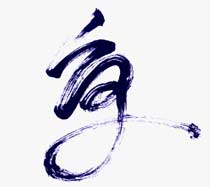 Uke:
Receiving
Uke:
Receiving
By Dave Lowry
Editor's Note:
This article is an excerpt from "Sword And Brush," a book
detailing martial arts strategic principles the author considers to
be important to a broad range of Japanese martial arts. In this book
he explains various characters and their meaning in the context of the
martial arts. This excerpt addresses the meaning of the kanji character
"Uke."
 When
the conversation leads to the subject of toughness, as inevitably it
will among young men and women in transit on the Way, opinions will
flow liberally. This master, it will be recounted, knocked an opponent
senseless with the briefest riposte. That one, someone will say, uprooted
young trees with his bare hands. Still another will be said to crush
stalks of green bamboo with his bare hands. Comparative feats of strength
are presented as proof of toughness in these conversations, especially
those among younger bugeisha (a student of old style martial arts).
The more senior exponents, however, tend to have a different way of
measuring toughness. With experience comes too,
the knowledge that toughness is less a matter of dishing it out and
is really more the ability to receive.
When
the conversation leads to the subject of toughness, as inevitably it
will among young men and women in transit on the Way, opinions will
flow liberally. This master, it will be recounted, knocked an opponent
senseless with the briefest riposte. That one, someone will say, uprooted
young trees with his bare hands. Still another will be said to crush
stalks of green bamboo with his bare hands. Comparative feats of strength
are presented as proof of toughness in these conversations, especially
those among younger bugeisha (a student of old style martial arts).
The more senior exponents, however, tend to have a different way of
measuring toughness. With experience comes too,
the knowledge that toughness is less a matter of dishing it out and
is really more the ability to receive.
| "With
experience comes too, the knowledge that toughness is less a
matter of dishing it out and is really more the ability to receive." |
Uke is a pictographic kanji (Japanese character), one written to depict
two hands, one reaching down, the other stretching up, and between them
is placed the character for "boat." This "conveyance
of goods from one person to another" became, over the centuries,
the kanji to indicate the act of "receiving." The bugeisha
uses the word frequently. In grappling bugei, the method of falling
safely are collectively called "ukemi," the "receiving
body." In judo terminology, the exponent thrown is "uke,"
the "receiver." Of the pair in karate practice, the one under
attack is the "ukete," the "receiving hand." In
kendo, the defender is "ukedachi," the "receiving sword."
In these and other expressions in the bugei lexicon, the importance
of the term "uke" is significant. It is commonly mistranslated
in judo circles as the "taker" of a technique.
Uke is thrown and so is considered the "loser" in this
way of thinking.
| "To
be on the uke end of training is not to be passively accepting
of the technique. It is instead the attitude of receiving, meeting
the throw on one's own terms." |
To understand that "uke" means more exactly "to receive"
opens new views for the practitioner. To be on the uke end of training
is not to be passively accepting of the technique. It is instead the
attitude of receiving, meeting the throw on one's own terms. The mentality
of the uke is not one of resignation or worse yet, of stubborn resistance.
The uke flows, absorbs the force of the throw, and while he does fall,
his ukemi does not necessarily signal defeat. His fall is one he controls.
He receives -- and bounces up again.
The term "ukete" in karate and "ukedachi" in kendo
are subject to a similarly misleading translation. Here they are thought
of incorrectly as designating the participant who "blocks"
an attack. Not so. The "ukekata," or "receiving forms"
of kendo and karate require a receiving of the incoming force in order
to redirect it away or to use it to come back against the attacker.
In the mature training hall will be very senior bugeisha, older men
and women, and they can be seen happily taking falls or blows, over
and over, from children trainees. Against adolescent members, young
and full of themselves, the senior will be just as complacent, mildly
taking all the excess energy of youth without a bruise or wince, until,
among the brightest of the youngsters, will come the realization that
there is something more to all this activity than it seems. They will,
some of them, begin to suspect that the toughness of these older bugeisha
is a thing yet to be discovered out there along the way. They will have
begun to see the true toughness of receiving.
About The Author:
Dave Lowry is a writer and historian specializing in Japan and traditional
Japanese culture. He has been a student of the modern and classical
martial disciplines of Japan since 1968 - including karate, aikido,
the bo and kenjitsu. His columns have appeared for years in a variety
of martial arts magazines and he is also an accomplished calligrapher.
His books include "Sword and Brush - The Spirit of the Martial
Arts" and "Autumn Lightning: The Education of an American
Samurai".
Printed with permission of Dave
Lowry.
Copyright © Dave Lowry. All rights reserved.